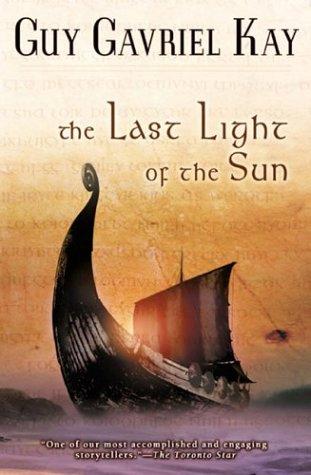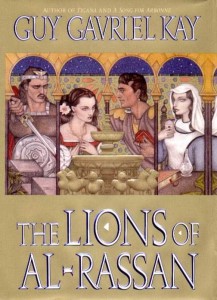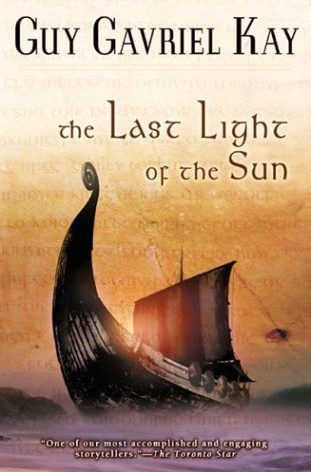Author Archives: Guy Gavriel Kay

Someone’s gonna get their shit Vik’d up.
I was talking to my dad not too long ago about a book on medieval history we’d both read, and he brought up the fact that he rarely reads fiction. “History’s more interesting,” he said, “and usually more unbelievable.” I don’t agree, but there’s a point there that applies especially well to fantasy – there is a vast wealth of Cool Shit That Actually Happened out there, and if you mine it carefully you can write one hell of a story.
Or, you can be Canadian fantasist Guy Gavriel Kay, and just dive headlong into it. Kay has straddled the line between historical fiction and fantasy for decades, placing a number of stories in a carbon-copy world laced with veins of the supernatural. It’s not surprising for a guy who got his start helping Christopher Tolkien edit the Silmarillion, but what does surprise is how well this formula has worked for him over the course of seven fantasy-analogue novels.
(Note: Kay’s written a few other things in the fantasy genre, like his most well-known work, The Fionavar Tapestry. I’m focusing on a few of the “historical fantasy” books with this review instead.)
Take Last Light of the Sun, probably the best of Kay’s stand-alone books. In what is clearly the British Isles, “Erling” raiders prey on the urban “Anglcyn” and sheep-herding “Cyngael” alike, and clerics of the solar deity “Jad” (my favorite rename; just say it out loud) attempt to shepherd the western edge of the world towards civilization. It’s essentially an imaginative retelling of a little chunk of the reign of Alfred the Great, mixed up with Viking sagas (The Sons of Ragnar Lodbrok being the main one.) But holy shit if Kay doesn’t make it work, with a narrative that bends away from the conventional fantasy epic you might expect, and a theme of “the magic goes away” – the fading of old pagan powers and supernatural elements – that’s well-worn but works exceptionally well here. It tends to show up in all of Kay’s historical-fantasy, which isn’t surprising as they all share a world.

The Lions are a metaphor, if you were wondering.
The other shared thing, of course, is the prose. Guy Gavriel Kay is as poetic and adept a descriptive writer as anyone in speculative fiction; at times, he’s as much lingering in his settings, inviting readers to explore them, as he is using them to base stories. This may be most evident in The Lions of Al-Rassan, which plays with the Caliphate of Moorish Spain and the life of El Cid. Rodrigo Belmonte, the El Cid analogue, is a deep thinker for a horseback swashbuckler, and his counterpart, a Caliphate courtier and assassin, fancies himself first and foremost a poet. (“It is increasingly unlikely,” he muses after poisoning another character, “That I will be best remembered for my poetry.”) This is where knowing the inevitable ending of Kay’s historical template comes in handy; the end of the Islamic golden age in Spain is foreshadowed throughout the book, and helps the author deliver a steaming plateful of sad.
The downside of the historical template, or maybe just a result of what Kay likes to write about, is the proliferation of legendary characters; when you draw your influences from texts about the foremost figures of their age, you’re going to end up with some ludicrously impressive people. This is most evident in The Sarantine Mosaic, a duology about turmoil in the Byzantine Empire (or a place to that effect). The narrator, a Romanesque artist named Caius Crispus (Crispin to both of his friends), is, well, a bit of a Gary Stu – courted by powerful women, befriended by impressive men, taking a great role in events far beyond him, and able to repeatedly use his talents as a mosaicist in practical scenarios ranging from Imperial court games to mano-a-mano combat. Kay was probably trying to craft someone who can stand alongside rewrites of Justinian, Theodora, et. al., but Crispin is a pretty grating character in his consistent amazingness.
Still, the Mosaic is a fun read because the most out of any of his books, it’s an exploration of the world he’s using. One of the running themes of Kay’s work is that his protagonists don’t affect history in the ways they want or expect to; it’s a conceit that lets him use history as his playground without it just coming off as particularly advanced fan-fic. This is best achieved when he swerves aside from his main cast and shows the various people of Sarantium, Al-Rassan, or Anglcyn trying to go about their lives, some of which end up being, in a historical context, far more notable than his protagonists. At worst, it’s a neat pacing trick, and sometimes (like the story of a farm girl who witnesses key events in Last Light) it’s as powerful a set of images as anything else in Kay’s books.
What Guy Gavriel Kay offers a reader, besides great prose and surprising sly wit, is a setting that’s an idealized version of history – or not idealized, really, cause it can be a pretty grody place. Maybe “romanticized” in an old sense; everything’s scaled up ten percent, the smart people are that much smarter, the villains are that much more evil, the heroes that much more conflicted, and so on. It’s a hell of a way to learn first-millenium history; when you compare it to actual events, there’s a deal less narrative coherence, but it’s amazing how much of this stuff actually happened. People are weird, and awful, and occasionally wonderful, and have been forever; Kay’s best trait as an author is his ability to remind of us that and keep it interesting. Check him out.






